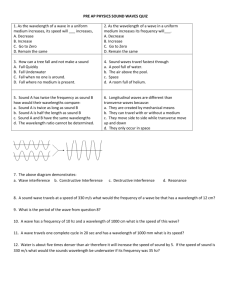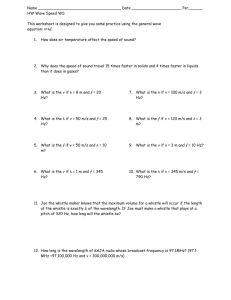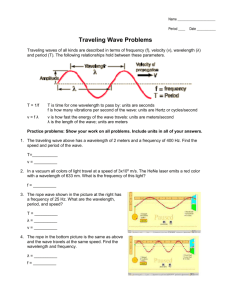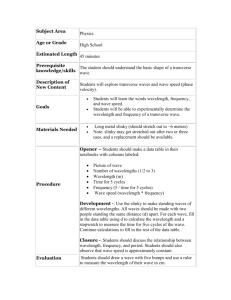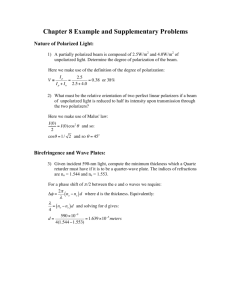PLC Activity #9 - Cabrillo College
advertisement
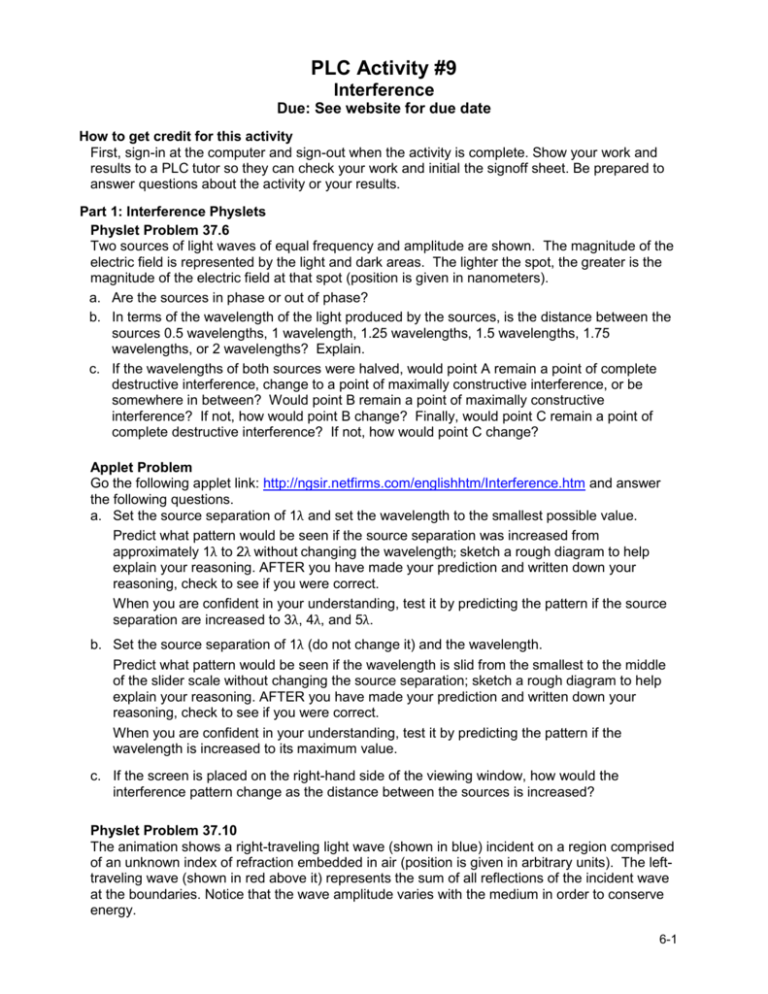
PLC Activity #9 Interference Due: See website for due date How to get credit for this activity First, sign-in at the computer and sign-out when the activity is complete. Show your work and results to a PLC tutor so they can check your work and initial the signoff sheet. Be prepared to answer questions about the activity or your results. Part 1: Interference Physlets Physlet Problem 37.6 Two sources of light waves of equal frequency and amplitude are shown. The magnitude of the electric field is represented by the light and dark areas. The lighter the spot, the greater is the magnitude of the electric field at that spot (position is given in nanometers). a. Are the sources in phase or out of phase? b. In terms of the wavelength of the light produced by the sources, is the distance between the sources 0.5 wavelengths, 1 wavelength, 1.25 wavelengths, 1.5 wavelengths, 1.75 wavelengths, or 2 wavelengths? Explain. c. If the wavelengths of both sources were halved, would point A remain a point of complete destructive interference, change to a point of maximally constructive interference, or be somewhere in between? Would point B remain a point of maximally constructive interference? If not, how would point B change? Finally, would point C remain a point of complete destructive interference? If not, how would point C change? Applet Problem Go the following applet link: http://ngsir.netfirms.com/englishhtm/Interference.htm and answer the following questions. a. Set the source separation of 1λ and set the wavelength to the smallest possible value. Predict what pattern would be seen if the source separation was increased from approximately 1λ to 2λ without changing the wavelength; sketch a rough diagram to help explain your reasoning. AFTER you have made your prediction and written down your reasoning, check to see if you were correct. When you are confident in your understanding, test it by predicting the pattern if the source separation are increased to 3λ, 4λ, and 5λ. b. Set the source separation of 1λ (do not change it) and the wavelength. Predict what pattern would be seen if the wavelength is slid from the smallest to the middle of the slider scale without changing the source separation; sketch a rough diagram to help explain your reasoning. AFTER you have made your prediction and written down your reasoning, check to see if you were correct. When you are confident in your understanding, test it by predicting the pattern if the wavelength is increased to its maximum value. c. If the screen is placed on the right-hand side of the viewing window, how would the interference pattern change as the distance between the sources is increased? Physlet Problem 37.10 The animation shows a right-traveling light wave (shown in blue) incident on a region comprised of an unknown index of refraction embedded in air (position is given in arbitrary units). The lefttraveling wave (shown in red above it) represents the sum of all reflections of the incident wave at the boundaries. Notice that the wave amplitude varies with the medium in order to conserve energy. 6-1 Observe how the intensity of light transmitted through the medium changes by using the slider to change the wavelength of incident light. Note: Because the data points are connected, you must move the slider slowly to obtain a smooth curve. a. Why is there numerous transmission peaks? b. What is the index of refraction of the material? c. Mathematically prove that the transmission peaks must be spaced further apart as the wavelength increases. Part 2: Ranking Problems Question 1 The graph shows the light intensity on a screen from a double-slit. a. For the data given in the table below, (i) calculate and (ii) draw a picture in the box of how a photograph taken at this location would look like. As guide, use the diagram to the left so that your picture aligns with the graph. Let the white of the paper represent the brightest intensity and the darkest you can draw with a pencil or pen be the least intensity. b. Using the same horizontal scale as in part (a), draw graphs showing the light intensity for graphs 1-6. c. Rank the fringe separation from greatest to least. 6-2 Question 2 The figure shows the viewing screen in a double-slit experiment. a. What will happen to the fringe spacing if the wavelength of the light is decreased? b. What will happen to the fringe spacing if the spacing between the slits is decreased? c. What will happen to the fringe spacing if the distance to the screen is decreased? d. Suppose the wavelength of the light is 500 nm, how much farther did the light wave have to travel (say slit-2) compare to the other slit (slit-1 such that they both arrive to the dot on the screen centered on fringe E? Question 3 The figures (1 and 2) shows a wave transmitted from air through a thin oil film on water. The film has a thickness of L. Answer the following questions for each situation. i. Indicate at a each boundary on the diagram whether the reflectged wave (not shown) undegoes a phase change at the boundary. What is the phase change? ii. Draw in the reflected wave from the first boundary (air/oil) and the reflectged wave from the second boundary (oil/water). Extend both reflected waves back to the left edge of the figure. iii. Do the two reflected waves interfere constructively, destructively, or in between? Explain? a. Figure 1: A wave is transmitted from air through a thin oil film on water. The film has a thickness of L. b. Figure 2: A wave is transmitted from air through a thin oil film on glass. The film has a thickness of L. Question 4 The figure shows the fringes seen due to a wedge of air between two flat glass plates that touch at one end and are illuminated by light of wavelength λ = 500 nm. a. Sketch the two waves interfering to produce these interference patterns. b. By how much does the wedge of air increase in thickness as you move from one dark fringe to the next dark fringe? Explain. c. By how much does the wedge of air increase in thickness from one end of the above figure to the other? d. Suppose you fill the space between the glass plates with water. Will the spacing between the dark fringes get larger, get smaller, or stay the same? Explain. 6-3 6-4
